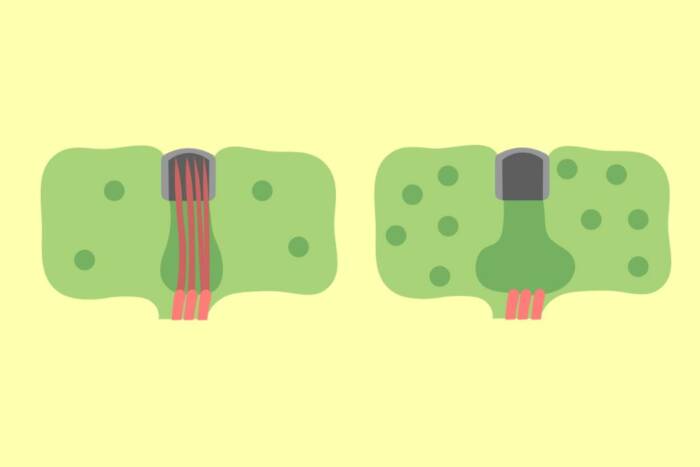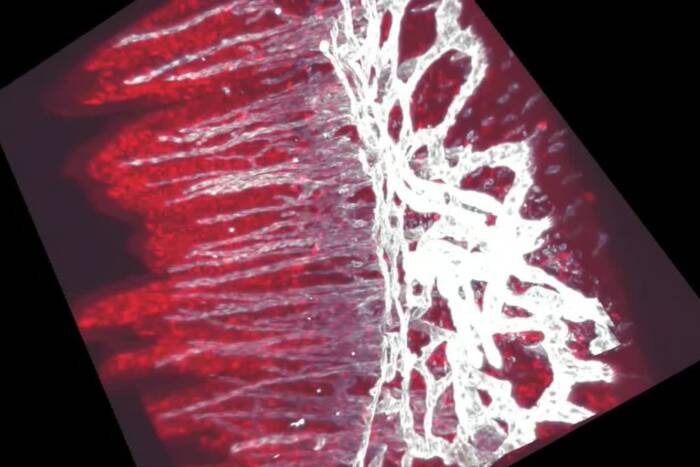Rockefeller Receives Horwitz Prize for Pioneering Work on How Genes are Turned On and Off

Robert Roeder (left) receives the Horwitz Prize from Columbia University President George Rupp.
Rockefeller University biochemist Robert Roeder, Ph.D., received the Louisa Gross Horwitz Prize from Columbia University on Thursday, Feb. 3. The prize, which Roeder shares with Robert Tjian, Ph.D., of the Howard Hughes Medical Institute at the University of California at Berkeley and Pierre Chambon, M.D., of the Université Louis Pasteur and the College de France, honors scientists for “outstanding basic research in biology or biochemistry.”
One of the most fundamental processes in biology is the way in which genetic information encoded in DNA is converted into proteins, a process called gene expression. At different times in the life of a cell, different genes are expressed, directing the synthesis of proteins in particular sequences and groupings. Just as musical instruments playing in programmed combinations can produce a symphony, gene expression is orchestrated.
The result for the cell can be its orchestrated development into a liver, heart, or skin cell, for example, or the decision to grow or to divide, or to interact with other cells to form tissues in the body. And when gene expression goes awry, a cell may turn cancerous.
The first step in gene expression is transcription–the switching on of a gene. DNA provides a sort of musical score, but what functions as the maestro, telling a gene to begin performing?
During the last 30 years, RU Professor Robert Roeder has answered this question with seminal contributions, and he provided much of the information that scientists know about the transcription process in animal cells.
While he has shared many prizes with Tjian in recent years–most notably last year’s Sloan Prize from the General Motors Cancer Research Foundation–Roeder’s work laid the foundation upon which discoveries by Tjian, Chambon and others were made.
Current research in the Roeder lab includes elucidating how transcription factors are activated. Some of these proteins orchestrate cells that mount the body’s defense against foreign invaders. Other factors flip the switch that keeps cell division in check–or causes tumors when it malfunctions. By demonstrating how the function of key factors is altered, Roeder’s lab may help clarify the reasons for various growth and developmental abnormalities. Ultimately, it may lead researchers to control these processes–and repair their pathological consequences.
“As we become familiar with the fundamentals of how genes work, we get closer to understanding diseases like cancer, or viral infections like HIV,” says Roeder, the university’s Arnold and Mabel Beckman Professor and head of the Laboratory of Biochemistry and Molecular Biology.
Roeder’s pioneering studies began when he was a graduate student at the University of Washington in the late 1960s.
“My career started in the early days of understanding what vertebrate genes were and how they function,” Roeder says. “I first became interested in gene activation because this process is at the center of cell growth and differentiation.”
Gene activation, the process of transcription, involves making an RNA copy of the gene from the DNA template. Constructing this copy requires enzymes known as nuclear RNA polymerases, which Roeder discovered while working in the laboratory of William J. Rutter. In a landmark paper published in 1969, he identified three polymerases, which he designated I, II and III, responsible for “reading out” DNA and synthesizing the three different types of RNA. Roeder also found three distinct groups of protein complexes, called accessory factors, that are essential for the individual RNA polymerases to recognize and copy particular classes of genes.
Roeder was also the first to identify the general factors–proteins common to the transcription process for any gene–for a number of different classes of genes, including class II genes, the ones that code for proteins in animal cells. The general factor called TFIID is a key member of this group, because it is the first to bind to the DNA control element called the TATA box, a short section of DNA that determines where transcription starts on the gene. RoederÕs lab showed that TFIID comprises a number of subcomponents specifically required for communication with the regulatory factors in addition to a small protein (TBP) that directly binds the TATA box and nucleates the assembly of RNA polymerase II and other general factors into a functional transcription complex. The structure of TBP in association with DNA and general factor TFIIB was solved in landmark studies by Professor Stephen Burley, an HHMI investigator.
“RNA polymerases and related accessory proteins, like TFIID, are general factors,” Roeder says. “All genes use them. But their functions on individual genes are dependent upon, and regulated by, proteins called activators that are specific to certain genes.”
In the late 1970s, Roeder developed systems in test tubes in which individual genes cloned by recombinant DNA techniques were transcribed precisely as in the normal cellular environment. Roeder identified and cloned the first gene-specific transcriptional regulatory factor, called TFIIIA. TFIIIA and similar proteins stimulate the copying of the target gene by the RNA polymerases and accessory factors. Hundreds of these transcription activators have been subsequently identified by RoederÕs lab and by others, and Roeder expects thousands more to be found that will regulate genes during such physiological processes as cell growth and division, and in hormonal processes, in virus infection and in tumor growth.
In the last five to 10 years, Roeder says, “We’ve uncovered a third layer of complexity in the transcription process with the discovery of coactivators.” Coactivators, which may also be gene- or cell-specific, enhance the function of DNA-bound activators by serving as adaptors or bridges between these components and the general transcription factor. Some of these are ubiquitous and broadly used for most genes, while others, like a B-cell-specific coactivator of immunoglobulin genes, are more specialized.
Last year, Roeder’s lab identified and characterized two large cofactor complexes found in human cells and showed that they are related structurally and functionally to protein complexes found in yeast. This provides further evidence that many molecules involved in this critical process are similar in organisms ranging from yeast to humans. However, some components novel to the human complexes were shown to be involved in the function of key regulators, like the tumor suppressor p53 and nuclear hormone receptors, that are not present in yeast.
Roeder says that over the years he has become increasingly interested in the applications of his research. “We need not only to understand the mechanisms underlying normal gene expression but to relate these to important medical problems at the same time,” he says.
By demonstrating how the function of key factors may be altered, the studies will help clarify the reasons for various abnormalities in growth, development, and virus infection. Ultimately, it may lead to methods by which these abnormalities and their health-threatening consequences may be controlled.


